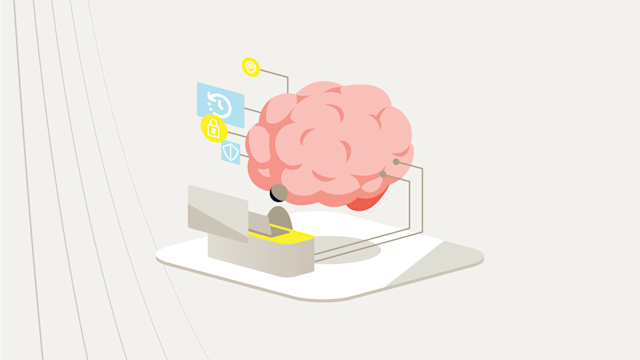Introduction to graph RAG
Explore how graph RAG combines retrieval augmented generation with knowledge graphs to enhance AI accuracy, offering improved contextual responses in healthcare, finance, and e-commerce.
The technology industry is constantly looking for new ways to make artificial intelligence (AI) more accurate, and there’s a new such effort in town.
You may have heard about knowledge graphs, which are knowledge systems that graph databases can implement. With knowledge graphs, the relationships between data points (or edges) are as useful and valuable as the data points (or vertices) themselves. That means they’re better at querying, traversing, and processing "connected data" and complex queries than traditional databases, which makes them especially well-suited for use cases involving identity resolution, network analysis, recommendation engines, customer 360, and fraud detection.
You may also have heard the term retrieval augmented generation (RAG), which improves generative artificial intelligence (GenAI) responses by retrieving and applying specific contextual information and adding it to the large language models (LLMs) those systems use. This is especially useful for specialized fields, such as healthcare and engineering. This contextual information, representing different aspects of a user's profile or situational data, helps craft relevant, more accurate, and deeply personalized responses.
What is graph RAG?
Graph RAG (retrieval augmented generation using graph databases) is emerging as a powerful advancement in AI, particularly in enhancing large language models (LLMs) with precise, domain-specific, and contextually relevant information. Unlike traditional RAG models, graph RAG is an advanced form of RAG that incorporates knowledge graphs into the retrieval process, offering structured, context-rich data for more accurate AI-generated responses. This allows large language models to retrieve and process graph data, making connections between data points and relationships more efficiently than traditional approaches. The integration of graph databases helps AI handle more complex queries by retrieving interconnected information across nodes and edges.
Key components of graph RAG:
Knowledge graphs: These are structured collections of entities (nodes) and relationships (edges) that form the foundation of graph RAG.
Nodes and edges: Nodes represent entities (e.g., people or products), and edges represent the relationships between them, such as ownership or affiliation.
Grounded context: Graph RAG enhances retrieval by accessing data from knowledge graphs, producing responses based on factual, interconnected information, rather than structured data.
How graph RAG differs from traditional RAG
Unlike traditional RAG models, which retrieve isolated facts from unstructured data, graph RAG gets structured, real-time information from knowledge graphs. This allows it to handle more complex queries and provide more nuanced, interconnected answers by mapping relationships between entities, such as companies and markets.
Contrary to traditional RAG, leveraging knowledge graphs enables better reasoning and inference by revealing relationships across layers of structured data. This improves retrieval efficiency, especially for large datasets and complex queries, making graph RAG more scalable for industries such as finance and research.
Benefits of graph RAG over traditional RAG
Enhanced accuracy: Traditional RAG models rely on unstructured data retrieval, often leading to incomplete outputs. Graph RAG, however, uses knowledge graphs to access more relevant data, making it more likely that responses are contextually accurate and well-connected to real-world relationships. This is critical for industries such as healthcare and finance, where understanding intricate data points makes it easier to resolve complex queries.
Thorough results: When integrated into AI applications, the information knowledge graphs contain about explicit relationships have been shown to increase the accuracy and completeness of GenAI responses.
Reduced hallucination: Like RAG itself, Graph RAG models help minimize AI-generated hallucinations by grounding responses in structured, factual data from knowledge graphs. This method provides a more reliable source of relevant information and reduces errors caused by relying solely on unstructured text.
Improved reasoning: The structure of graph data allows graph RAG models to make inferences that are more difficult to ascertain with raw text data. This capability is particularly valuable in scientific research and legal analysis, where discovering hidden relationships can lead to additional insights.
Technical challenges and best practices
Implementing graph RAG models presents several challenges due to the dynamic nature of data and the complexity involved. While graph RAG provides significant advantages in scalability, accuracy, and contextual relevance, managing real-time retrieval and ensuring consistent outputs adds its own challenges.
Technical challenges in implementing graph RAG
Data quality and relevance: The success of a graph RAG model relies on the quality of the knowledge graph. Inconsistent or outdated graph data can lead to inaccurate results. The structured data needs to be regularly updated to ensure relevant information is retrieved from potentially vast datasets.
Dynamic knowledge management: Handling dynamic knowledge is challenging, especially in environments where graph data is frequently updated. As knowledge graphs grow, updating vector indices becomes critical for maintaining scalability and efficiency. Systems must dynamically incorporate new data without requiring complete reindexing. A few workaround methods include incremental indexing, updating only the affected areas of the index; chunking and segmentation, splitting the graph into more manageable, smaller segments; and version control, where each change creates a new version of a node or relationship.
Transparency and explainability: In regulated industries, AI outputs need to be transparent and explainable. One challenge with graph RAG models is explaining clearly how specific data points were retrieved and used, which requires incorporating techniques such as prompt engineering.
Latency and retrieval efficiency: As graph RAG models manage increasingly large knowledge graphs, maintaining low-latency retrieval becomes harder. Without it,
Real-time applications, such as chatbots don’t work well. Solutions such as hybrid search (combining vector search with keyword search) and using more efficient traversal algorithms help reduce latency without sacrificing quality.
Best practices for overcoming technical challenges
Regular updates: Continuously update the knowledge graph to reflect real-time changes and ensure accurate retrieval without requiring reindexing.
Hybrid retrieval models: Use a combination of vector search and keyword search to balance retrieval efficiency and minimize latency. Adjust search parameters to improve performance based on query complexity.
Incorporate explainability techniques: Use prompt engineering to clarify decision-making processes in graph RAG outputs, particularly in regulated fields such as healthcare.
Scalable architecture design: Implement architectures that can handle large datasets without degrading performance, such as hybrid memory systems that store frequently accessed graph data in RAM for faster retrieval.
Monitor system performance: Continuously track system performance in terms of retrieval times and the accuracy of structured data. Ensure the system can dynamically adjust retrieval methods based on dataset complexity.
Industry applications of graph RAG
The ability of graph RAG to retrieve interconnected, contextually relevant information makes it valuable across multiple industries. By combining knowledge graphs with AI and natural language processing (NLP), graph RAG enhances decision-making with domain-specific knowledge and helps organizations gain actionable insights from complex queries. Its applications span industries such as telecommunications.
Telecommunications
In telecommunications, graph RAG maps networks of communication between devices, systems, and infrastructure. Using graph traversal algorithms, telecom companies can analyze relationships within their networks, identifying bottlenecks, improving efficiency, and predicting outages. For example, graph traversal techniques such as breadth-first search (BFS), an algorithm that explores all the nodes on a single level before moving on to the next level, and depth-first search (DFS), another algorithm with a more granular approach, where each branch of a graph is explored holistically, before proceeding to another branch, help engineers monitor data flow, pinpoint key nodes and paths that are prone to failure.
Healthcare
In healthcare, graph RAG models improve diagnostics and treatment recommendations by linking data sources such as patient records, genetic data, and medical research. Knowledge graphs help healthcare providers detect patterns that traditional methods might miss. Algorithms such as Dijkstra’s algorithm, which finds the shortest path between nodes in a weighted graph, help trace disease spread and identify the most efficient treatment pathways, leading to precise, timely care and reduced diagnostic errors.
Finance
Graph RAG helps the finance industry detect fraud, manage risk, and improve financial forecasting. By analyzing relationships between transactions, accounts, and customers, graph RAG models help institutions identify suspicious activity. Clustering techniques, such as community detection, group related accounts, while centrality measures, such as betweenness centrality, detect key nodes, making it easier to flag high-risk areas and potential fraud schemes.
E-commerce
In e-commerce, graph RAG enhances recommendation systems by analyzing relationships between products, users, and their purchasing behavior. Knowledge graphs help e-commerce platforms offer more accurate, personalized recommendations, improving customer satisfaction and boosting conversion rates. Clustering customers based on purchasing history allows graph RAG to identify popular products and understand consumer behavior more comprehensively.
Next steps
Aerospike is widely used in both knowledge graphs and RAG, so it’s no surprise that it’s worth looking at for graph RAG as well. Aerospike provides the infrastructure to support scalable, real-time graph processing that powers the advanced retrieval capabilities of graph RAG models. Aerospike’s Hybrid Memory Architecture and support for multiple data models mean large datasets can be processed more quickly. This is crucial for delivering the relevant information that graph RAG requires to generate accurate, contextually rich AI outputs in a timely manner. By enabling low-latency data access across regions, Aerospike helps graph RAG implementations operate more efficiently in real-time applications.
For organizations looking to optimize their AI performance and harness the benefits of graph RAG, integrating Aerospike is a key step in achieving both scalability and precision. Start leveraging Aerospike today to power your real-time, scalable AI solutions.




